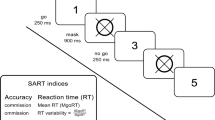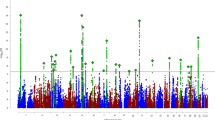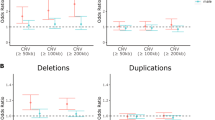Abstract
One particular candidate gene, the dopamine D4 receptor (DRD4), has been the focus of intense study regarding ADHD since the original investigation by La Hoste et al,1 an observation confirmed by a recent metaanalysis.2 However, two previous studies from Israel failed to observe this association.3,4We have now recruited an additional sample and, overall, in the combined sample of 178 triads we observe using the transmission disequilibrium test,5,6 preferential transmission of the short allele. Additionally, we now report the effect of the DRD4 repeat region on the Test Of Variables of Attention (TOVA), a widely used computerized continuous performance test.7 Probands with the short exon III repeat performed significantly worse on the TOVA measured both by errors of commission and response time variable. Intriguingly, a ‘dose effect’ was observed. Increasing repeat size is accompanied by a reduced number of errors of commission and a significant difference is observed between the 2 vs 7 repeats. On the whole, our results lend credence to the notion that the relationship between the DRD4 receptor and ADHD is complex and may be reflecting linkage disequilibrium between the 7 or long DRD4 exon III repeats and a ‘true’ risk allele in this gene or a neighboring locus.
This is a preview of subscription content, access via your institution
Access options
Subscribe to this journal
Receive 12 print issues and online access
$259.00 per year
only $21.58 per issue
Buy this article
- Purchase on Springer Link
- Instant access to full article PDF
Prices may be subject to local taxes which are calculated during checkout

Similar content being viewed by others
References
LaHoste GJ et al. Dopamine D4 receptor gene polymorphism is associated with attention deficit hyperactivity disorder Mol Psychiatry 1996; 1: 121–124
Faraone SV, Doyle AE, Mick E, Biederman J . Meta-analysis of the association betwen the 7-repeat allele of the dopamine D(4) receptor gene and attention deficit hyperactivity disorder Am J Psychiatry 2001; 158: 1052–1057
Eisenberg J et al. A haplotype relative risk study of the dopamine D4 receptor (DRD4) exon III repeat polymorphism and attention deficit hyperactivity disorder (ADHD) Am J Med Genet 2000; 96: 258–261
Kotler M et al. Failure to replicate an excess of the long dopamine D4 exon III repeat polymorphism in ADHD in a family-based study Am J Med Genet 2000; 96: 278–281
Spielman RS, McGinis RE, Ewens WJ . Transmission test for linkage disequilibrium: the insulin gene region and insulin-dependent mellitus (IDDM) Am J Hum Genet 1993; 52: 506–516
Ewens WJ, Spielman RS . The transmission/disequilibrium test: history, subdivision and admixture Am J Hum Genet 1995; 57: 455–464
Greenberg LM, Waldman ID . Developmental normative data on the test of variables of attention (TOVA) J Child Psychol Psychiatry 1993; 34: 1019–1030
Ebestein RP, Benjamin J, Belmaker RH . Personality and polymorphisms of genes involved in aminergic neurotransmission Eur J Pharmacol 2000; 410: 205–214
Pliszka SR, McCracken JT, Maas JW . Catecholamines in attention-deficit hyperactivity disorder: current perspectives J Am Acad Child Adolesc Psychiatry 1996; 35: 264–272
Cardinal RN, Pennicott DR, Sugathapala CL, Robbins TW, Everitt BJ . Impulsive choice induced in rats by lesions of the nucleus accumbens core Science 2001; 292: 2499–2501
Asghari V et al. Modulation of intracellular cyclic AMP levels by different human dopamine D4 receptor variants J Neurochem 1995; 65: 1157–1165
Asghari V et al. Dopamine D4 receptor repeat: analysis of different native and mutant forms of the human and rat genes Mol Pharmacol 1994; 46: 364–373
Jovanovic V, Guan HC, Van Tol HH . Comparative pharmacological and functional analysis of the human dopamine D4.2 and D4.10 receptor variants Pharmacogenetics 1999; 9: 561–568
Kazmi MA, Snyder LA, Cypess AM, Graber SG, Sakmar TP . Selective reconstitution of human D4 dopamine receptor variants with Gi alpha subtypes Biochemistry 2000; 39: 3734–3744
Paterson AD, Sunohara GA, Kennedy JL . Dopamine D4 receptor gene: novelty or nonsense? Neuropsychopharmacology 1999; 21: 3–16
Okuyama Y et al. Identification of a polymorphism in the promoter region of DRD4 associated with the human novelty seeking personality trait Mol Psychiatry 2000; 5: 64–69
Mitsuyasu H et al. Association analysis of polymorphisms in the upstream region of the human dopamine D4 receptor gene (DRD4) with schizophrenia and personality traits J Hum Genet 2001; 46: 26–31
Barr CL et al. 5′-Untranslated region of the dopamine D4 receptor gene and attention-deficit hyperactivity disorder Am J Med Genet 2001; 105: 84–90
Schork NJ et al. The future of genetic case-control studies Adv Genet 2001; 42: 191–212
Pritchard JK . Are rare variants responsible for susceptibility to complex diseases? Am J Hum Genet 2001; 69: 124–137
Barr CL et al. Further evidence from haplotype analysis for linkage of the dopamine D4 receptor gene and attention-deficit hyperactivity disorder Am J Med Genet 2000; 96: 262–267
Conners CK . Rating scales in attention-deficit/hyperactivity disorder: use in assessment and treatment monitoring J Clin Psychiatry 1998; 59 Suppl 7: 24–30
Achenbach TM, Edelbrock CS . Behavioral problems and competencies reported by parents of normal and disturbed children aged four through sixteen Monogr Soc Res Child Dev 1981; 46: 1–82
Wechsler D Psychological Corporation. WISC-II. (kit) Wechsler Intelligence Scale for Children Psychological Corporation, Harcourt Brace Jovanovich: San Antonio, TX 1991
Acknowledgements
This research was supported by a grant from the Israeli Ministry of Health.
Author information
Authors and Affiliations
Corresponding author
Rights and permissions
About this article
Cite this article
Manor, I., Tyano, S., Eisenberg, J. et al. The short DRD4 repeats confer risk to attention deficit hyperactivity disorder in a family-based design and impair performance on a continuous performance test (TOVA). Mol Psychiatry 7, 790–794 (2002). https://doi.org/10.1038/sj.mp.4001078
Received:
Revised:
Accepted:
Published:
Issue Date:
DOI: https://doi.org/10.1038/sj.mp.4001078
Keywords
This article is cited by
-
Dopamine D4 Receptor Gene Associated with the Frontal-Striatal-Cerebellar Loop in Children with ADHD: A Resting-State fMRI Study
Neuroscience Bulletin (2018)
-
Genetic contributions to attentional response time slopes across repeated trials
BMC Neuroscience (2015)
-
ADHD History of the Concept: the Case of the Continuous Performance Test
Current Developmental Disorders Reports (2015)
-
The 1287 G/A polymorphism of the Norepinephrine Transporter gene (NET) is involved in Commission Errors in Korean children with Attention Deficit Hyperactivity Disorder
Behavioral and Brain Functions (2011)
-
Neuropsychological endophenotypes in attention-deficit/hyperactivity disorder: a review of genetic association studies
European Archives of Psychiatry and Clinical Neuroscience (2011)



